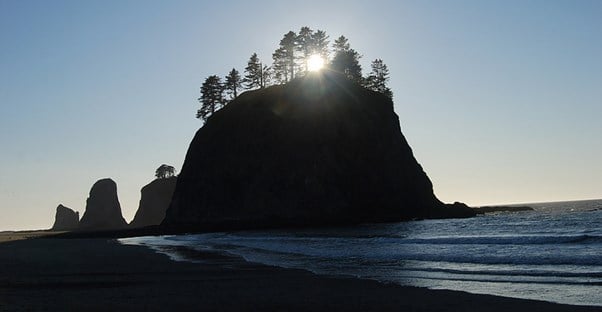15. Mammoth Cave National Park

Kentucky
The longest cave system on earth was sure to find a place on this list. Located in the heart of Kentucky, Mammoth Cave National Park’s over 400 miles of underground tunnels contain cave shrimp, salamanders, and at least eight different species of bats. The park also boasts over 70 miles of aboveground trails surrounding the Green River.
(image via Daniel Schwen, CC)
14. Redwood National and State Parks

California
Unleash your inner Ewok as you set foot on the filming location for the forest moon of Endor from Return of the Jedi. Nearly half of all remaining redwoods are found within the borders of the park. Many visitors are also intrigued by the tide pools that form along the coast, containing a variety of sea life.
(image via Michael Schweppe, CC)
13. North Cascades National Park

Washington
Going back to the Pacific Northwest, we find the North Cascades National Park. The mountains that serve as the park’s namesake stretch over 700 miles, offering countless trails for hikers. Make sure you allow yourself time to kayak Ross Lake. With few buildings or paved roads, this isn't your easy family weekend getaway.
(image via Daniel Hershman, CC)
12. Big Bend National Park
11. Hot Springs National Park

Arkansas
The oldest and smallest park on this list, Hot Springs allows access to 19th-century bathhouses that utilize the natural hot springs that give the park its name. This area combines Spanish colonial and art deco architecture along with the surrounding natural beauty to satisfy the needs of all who pass through central Arkansas.
10. Great Smoky Mountains National Park

North Carolina and Tennessee
Due in part to its convenient location, this park is the most visited in the United States. Part of the greater Appalachian Mountains, the Smokies are known for their scenic hiking trails and their thousands of species of plant life. Be sure to snap a photo of Clingmans Dome, from the top of which you can see seven different states.
9. Grand Canyon

Arizona
Arguably America’s most famous natural landmark, the Grand Canyon is a crevasse 15 miles wide and over a mile deep formed by millions of years of erosion by the Colorado River. Visitors from all over the world come to see the various layers of exposed rock that make up the sides of this enormous canyon.
(image via frankpierson, CC)
8. Rocky Mountain National Park

Colorado
Come and see why John Denver was singing about this enormous mountain range. The Rockies are home to beautiful forests, over 70 peaks that are more than 12,000 feet tall, and some species of animals that aren’t found anywhere else in the world. If you keep an eye out, you may be able to see bighorn sheep and black bears.
7. Glacier National Park

Montana
With crystal clear lakes, a breathtaking view of the Rocky Mountains, beautifully preserved fossils, and (you guessed it) 26 glaciers, Glacier National Park is home to some of the greatest natural gifts Montana has to offer. But you need to go quickly, as experts say that the glaciers will most likely have melted in the next twenty years.
(image via Mountain walrus, CC)
6. Acadia National Park

Maine
To visit one of the few parks in the eastern United States, travel to Maine for Acadia National Park. Spanning nearly 50,000 acres, this island park features rocky beaches, thick forests, and Cadillac Mountain, the tallest shoreline point on the U.S. Atlantic Coast. Hike one of the famous trails, including one 130 miles long.
5. Crater Lake National Park

Oregon
There are few places in this country that impress nature lovers more than Oregon. Lying in the mouth of a dormant volcano, Crater Lake provides visitors a view into the dark blue waters of the deepest lake in the United States. When Mount Mazama imploded over 7,000 years ago, it created this geological phenomenon which is unlike anything else on the planet.
(image via Don Graham, CC)
4. Yosemite National Park

California
Known for its steep cliffs and raging waterfalls, Yosemite is an adventurer’s paradise. One of the most daring sights is the Dawn Wall of El Capitan, which is regarded by many to be the toughest rock climbing destination on earth. It only experienced its first free climb ascent in January of this year.
(image via Esther Lee, CC)
3. Sequoia National Park

California
Here, you can find General Sherman, the world’s largest tree, along with an entire forest of massive trees that give the park its name. Bask in the presence of some of the oldest living organisms on the planet. Sequoia is also home to Mount Whitney, the tallest mountain in the continental United States.
(image via miguelvieira, CC)
2. Yellowstone National Park

Wyoming, Montana, and Idaho
Old Faithful, alone, is one of America’s proudest landmarks. An insane amount of geological occurrences had to line up to make Yellowstone a reality. Come and see the vivid colors and explosive geysers that showcase the power of thermal activity.
(image via Esther Lee, CC)
1. Olympic National Park

Washington
One of the last remaining rainforests in the U.S., the Hoh River Rain Forest is a must-see for any traveler. Olympic National Park is also home to the Olympic Mountains and a canyon that is 200 feet deep, displaying the various ecosystems of the scenic Pacific Northwest.
(image via Kashyap Hosdurga, CC)
 Author
Brian Thompson
Last Updated: April 05, 2016
Author
Brian Thompson
Last Updated: April 05, 2016

